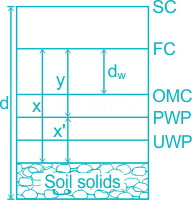The limiting Moment of Resistance of a RCC Beam is given as:
Mu,lim = 0.362Bfck Xu,lim (d-0.42 Xu,Lim)
Where symbols have their usual meaning
Further, the Xu,lim/d ratio depends on grade of steel being used, which is referred from the below table:
|
Grade of Steel |
Xu,lim/d |
|
Fe 250 |
0.53 |
|
Fe 400 |
0.48 |
|
Fe 500 |
0.46 |
Development Length of Steel bar in RCC
Development length:
(i) The calculated tension or compression in any bar at any section shall be developed on each side of the section by an appropriate development length or end anchorage or a combination thereof.
ϕ = Diameter of bar
τbd = Design bond stress = Permissible value of average bond stress
The value of bond stress is increased by 60% for a deformed bar in tension and a further increase of 25% is made for bars in compression.
In case of bundled bars in contact the development length is increased than that for individual bar by
- 10% for two bars in contact
- 20% for three bars in contact
- 33% for four bars in content














